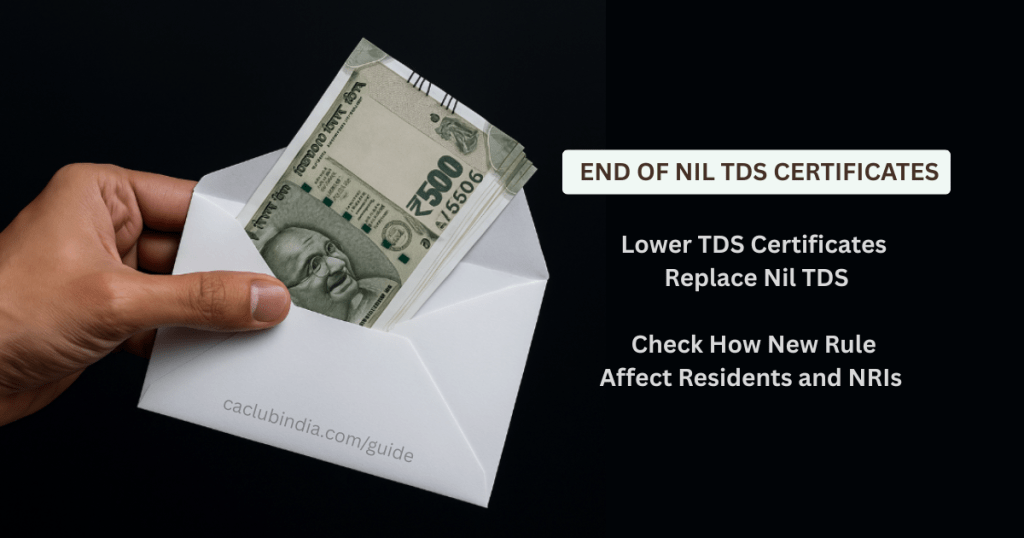TDS (Tax Deducted at Source) is a system introduced by the Income Tax Department whereby a person or entity making certain payments (such as salary, interest, rent, etc.) deducts tax at a prescribed rate before making the full payment to the recipient. The deducted tax is then deposited with the government.
The person from whom tax is deducted (e.g., employee, contractor, landlord) can claim credit for the TDS amount while filing their ITR.
Section 192 of the Income Tax Act, 1961, mandates employers to deduct Tax Deducted at Source (TDS) from an employee’s salary income if it exceeds the basic exemption limit.
- Payer – Resident/NR employer (company, firm, individual, HUF, etc.)
- Payee – Employee (The person receiving the salary)
Time of deduction
- On payment.
- Eligible start up referred to in S. 80- IAC, responsible for paying any income to the assessee by way of perquisite being any specified security or sweat equity shares allotted or transferred, directly or indirectly, free of cost or at concessional rate to the assessee – 14 days from the earliest of the following dates –
- after the expiry of 48 month from the end of the AY
- from the date of the sale of such specified security or sweat equity share by the assessee; or
- from the date of the assessee ceasing to be the employee of the employer
- Such tax has to deducted or paid on the basis of rates in force for the financial year in which the said specified security or sweat equity share is allotted or transferred.
Rates
TDS as per Tax Regime selected by employee. If not selected, TDS deduction as per New Regime.
| FY 24 – 25 | FY 25 – 26 |
| Up to 3,00,000 = Nil 3,00,001 – 7,00,000 = 5% 7,00,001 – 10,00,000 = 10% 10,00,001 – 12,00,000 = 15% 12,00,001 – 15,00,000 = 20% Above 15,00,000 = 30% | Up to 4,00,000 = Nil 4,00,001 – 8,00,000 = 5% 8,00,001 – 12,00,000 = 10% 12,00,001 – 16,00,000 = 15% 16,00,001 – 20,00,000 = 20% 20,00,001 – 24,00,000 = 25% Above 24,00,000 = 30% |
How To Calculate
- Average rate of Tax + Health & Education Cess (Surcharge if Salary > 50 Lacs)
- Surcharge: Applicable if income exceeds ₹50 lakhs.
- Health & Education Cess: 4% on tax + surcharge.
Remarks
- If the employee intends to opt for Section 115BAC, he needs to inform to employer.
- If the employee is working for more than one employer, he may furnish the salary of the other employer for TDS.
- Salaries in forex – convert as per exchange – convert as per TTBR as on the date TDS is to be deducted [Rule 26].
- Relief u/s 89(1) to be calculated for arrears of salary paid to government employees or to companies, cooperative societies, local authorities, universities, institutions, associations or bodies.
- Employer to furnish Form 12BA giving correct and complete particulars of perquisites or profits in lieu of salary provided to him and the value.
- Employee to furnish Form 12BB giving the evidence of HRA [Name, address, PAN of landlord if the rent paid >Rs. 1Lakhs], LTC [details of expense], Int on HP [Name, address and PAN of lender], details of investment or expense for Chapter VIA deduction.
- Tips collected by the employer to be paid to the employee are not covered under salaries and are not liable for TDS u/s 192.
No TDS if Income Below Exemption Limit
No TDS is deducted if the employee’s estimated annual salary income is below the basic exemption limit. For the financial year 2024-25 (Assessment Year 2025-26), the basic exemption limits under the old tax regime are:
- ₹2,50,000 for individuals below 60 years of age.
- ₹3,00,000 for senior citizens (60 to 80 years).
- ₹5,00,000 for super senior citizens (above 80 years). Under the new tax regime, the basic exemption limit is ₹3,00,000 for all individuals.
TDS Deposit & Compliance by Employer
- Deposit TDS by the 7th of the next month (or quarterly if eligible).
- File TDS returns (Form 24Q) quarterly.
- Issue Form 16 (by 15th June) to employees.
Important TDS Forms
- Form 16 (for salaried employees) – Shows salary TDS details.
- Form 16A (for non-salary TDS) – For interest, rent, etc.
- Form 26AS – Consolidated TDS/TCS statement (available on Income Tax Portal).
Example
| Particulars | Amount |
| Gross Annual Salary | ₹8,75,000 |
| Standard Deduction (under the new regime) | ₹75,000 |
| Taxable Income: ₹8,75,000 – ₹75,000 | ₹8,00,000 |
| Income Tax Liability- | |
| Up to ₹3,00,000 | Nil |
| ₹3,00,001 – ₹7,00,000: 5% of (₹7,00,000 – ₹3,00,000) = 5% of ₹4,00,000 | ₹20,000 |
| ₹7,00,001 – ₹8,00,000: 10% of (₹8,00,000 – ₹7,00,000) = 10% of ₹1,00,000 | ₹10,000 |
| Total Income Tax: ₹0 + ₹20,000 + ₹10,000 | ₹30,000 |
| Health and Education Cess 4% of ₹30,000 | ₹1,200 |
| Total Estimated Tax Liability ₹30,000 + ₹1,200 | ₹31,200 |
| Monthly TDS: ₹31,200 / 12 | ₹2600 |
Related Articles
Income Tax Slab For The FY 2024-25
Old Tax Regime Slabs For FY 2024-25: Who Should Opt and Why?
Which ITR Form to File for FY 2024-25? Choose the Right One in Minutes
Old vs New Tax Regime: Which One Saves You More For FY 2024-25?
FAQs
TDS is deducted only when salary is actually paid, not when it is due. This includes advance or delayed salary payments.
If your estimated annual salary is below the basic exemption limit, no TDS is deducted — even if you don’t have a PAN.
If your salary exceeds the basic exemption limit, TDS is deducted based on the applicable income tax slab rates.


